
Engelin Teh (SC) Linda Ong
Division of assets and maintenance
The ancillary issues of division of assets as well as maintenance for the wife and the children of the marriage will have to be resolved whenever divorce proceedings arise. We have represented clients from all walks of life in resolving these financial matters on their behalf. Our work ranges from advising the client, drafting the necessary court documents as well as attending court hearings on behalf of the client. Very often, our work also entails negotiating with the opposing party to reach an amicable financial settlement. No matter the size of the claim or the nature of the dispute, we are committed to reaching the best possible outcomes for our clients.
How to apply for Maintenance?
For a detailed description on how to apply for maintenance, please see the <navigation tab> above.
How are Matrimonial assets divided?
For a detailed description on how the Court divides Matrimonial Assets, please see the <navigation tab> above.
We also act for clients in maintenance summons applications for spousal maintenance.

How to apply for Maintenance?
 If any of the questions are answered to the affirmative above, this article is relevant to you.
If any of the questions are answered to the affirmative above, this article is relevant to you.
Under S.69 of the Women’s Charter, maintenance can be applied:
- a) for your child, from the other parent, if he or she neglects or refuses to provide the child with reasonable maintenance;
- b) for yourself, from your husband, if you are a married woman whose husband neglects or refuses to provide you with reasonable maintenance; or
- c) for yourself, from your wife, if you are an incapacitated husband whose wife has neglected or refused to provide you with reasonable maintenance.
Factors the Court will consider in assessing maintenance [Section 69, Women’s Charter]:
| (a) | the financial needs of the wife, incapacitated husband or child; | ||||||
| (b) | the income, earning capacity (if any), property and other financial resources of the wife, incapacitated husband or child; | ||||||
| (c) | any physical or mental disability of the wife, incapacitated husband or child; | ||||||
| (d) | the age of each party to the marriage and the duration of the marriage; | ||||||
| (e) | the contributions made by each of the parties to the marriage to the welfare of the family, including any contribution made by looking after the home or caring for the family; | ||||||
| (f) | the standard of living enjoyed —
|
||||||
| (g) | in the case of a child, the manner in which he was being, and in which the parties to the marriage expected him to be, educated or trained; and | ||||||
| (h) | the conduct of each of the parties to the marriage, if the conduct is such that it would in the opinion of the court be inequitable to disregard it. |
Special considerations are also given for application for maintenance of a child below the age of 21, and these include:
- Mental or physical disability of the child;
- Whether the child is, or will be serving full-time national service;
- Whether the child is or will be receiving instruction at an educational establishment or undergoing training for a trade, profession or vocation, whether or not in gainful employment; or
- Special circumstances which the Courts could use as a justification to make the order for child maintenance.
How to apply?
To apply, you will need the following documents:

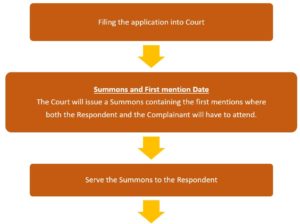
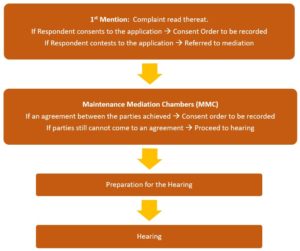


How does the court Divide Matrimonial Assets?
We will need to first define which assets amount to a Matrimonial Asset. Section 112(10) of the Women’s Charter provides the definition:
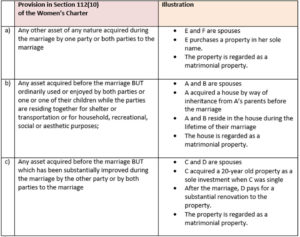
Typical examples of matrimonial assets are illustrated as follows:

How are matrimonial assets divided?
The court looks at the following factors:







During the lifetime of one’s marriage, spouses would have made contributions both financially and non-financially, indirect and direct. It is not only just about the direct financial contributions that spouses have contributed, but also indirect contributions which are made for the betterment of the marriage or towards the improvement of the family life. The Court will consider these contributions in deciding on division:
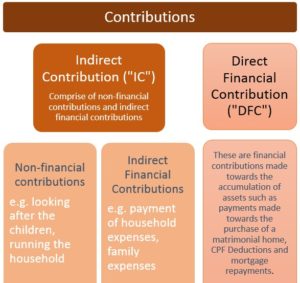
The Family Courts adopt a structured approach in identifying the ratio of parties’ contributions in three tiers:
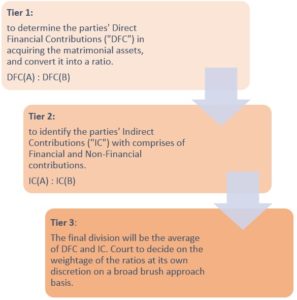

- Our Expertise
-

Engelin Teh (SC) Linda Ong
Division of assets and maintenance
The ancillary issues of division of assets as well as maintenance for the wife and the children of the marriage will have to be resolved whenever divorce proceedings arise. We have represented clients from all walks of life in resolving these financial matters on their behalf. Our work ranges from advising the client, drafting the necessary court documents as well as attending court hearings on behalf of the client. Very often, our work also entails negotiating with the opposing party to reach an amicable financial settlement. No matter the size of the claim or the nature of the dispute, we are committed to reaching the best possible outcomes for our clients.
How to apply for Maintenance?
For a detailed description on how to apply for maintenance, please see the <navigation tab> above.
How are Matrimonial assets divided?
For a detailed description on how the Court divides Matrimonial Assets, please see the <navigation tab> above.
We also act for clients in maintenance summons applications for spousal maintenance.
- How to Apply for Maintenance?
-

How to apply for Maintenance?
 If any of the questions are answered to the affirmative above, this article is relevant to you.
If any of the questions are answered to the affirmative above, this article is relevant to you.Under S.69 of the Women’s Charter, maintenance can be applied:
- a) for your child, from the other parent, if he or she neglects or refuses to provide the child with reasonable maintenance;
- b) for yourself, from your husband, if you are a married woman whose husband neglects or refuses to provide you with reasonable maintenance; or
- c) for yourself, from your wife, if you are an incapacitated husband whose wife has neglected or refused to provide you with reasonable maintenance.
Factors the Court will consider in assessing maintenance [Section 69, Women’s Charter]:
(a) the financial needs of the wife, incapacitated husband or child; (b) the income, earning capacity (if any), property and other financial resources of the wife, incapacitated husband or child; (c) any physical or mental disability of the wife, incapacitated husband or child; (d) the age of each party to the marriage and the duration of the marriage; (e) the contributions made by each of the parties to the marriage to the welfare of the family, including any contribution made by looking after the home or caring for the family; (f) the standard of living enjoyed — (i) by the wife before her husband neglected or refused to provide reasonable maintenance for her; (ii) by the incapacitated husband before his wife neglected or refused to provide reasonable maintenance for him; or (iii) by the child before a parent neglected or refused to provide reasonable maintenance for the child; (g) in the case of a child, the manner in which he was being, and in which the parties to the marriage expected him to be, educated or trained; and (h) the conduct of each of the parties to the marriage, if the conduct is such that it would in the opinion of the court be inequitable to disregard it. Special considerations are also given for application for maintenance of a child below the age of 21, and these include:
- Mental or physical disability of the child;
- Whether the child is, or will be serving full-time national service;
- Whether the child is or will be receiving instruction at an educational establishment or undergoing training for a trade, profession or vocation, whether or not in gainful employment; or
- Special circumstances which the Courts could use as a justification to make the order for child maintenance.
How to apply?
To apply, you will need the following documents:




- ' How does the Court divide Matrimonial Assets? '
-

How does the court Divide Matrimonial Assets?
We will need to first define which assets amount to a Matrimonial Asset. Section 112(10) of the Women’s Charter provides the definition:

Typical examples of matrimonial assets are illustrated as follows:

How are matrimonial assets divided?
The court looks at the following factors:







During the lifetime of one’s marriage, spouses would have made contributions both financially and non-financially, indirect and direct. It is not only just about the direct financial contributions that spouses have contributed, but also indirect contributions which are made for the betterment of the marriage or towards the improvement of the family life. The Court will consider these contributions in deciding on division:

The Family Courts adopt a structured approach in identifying the ratio of parties’ contributions in three tiers:

















